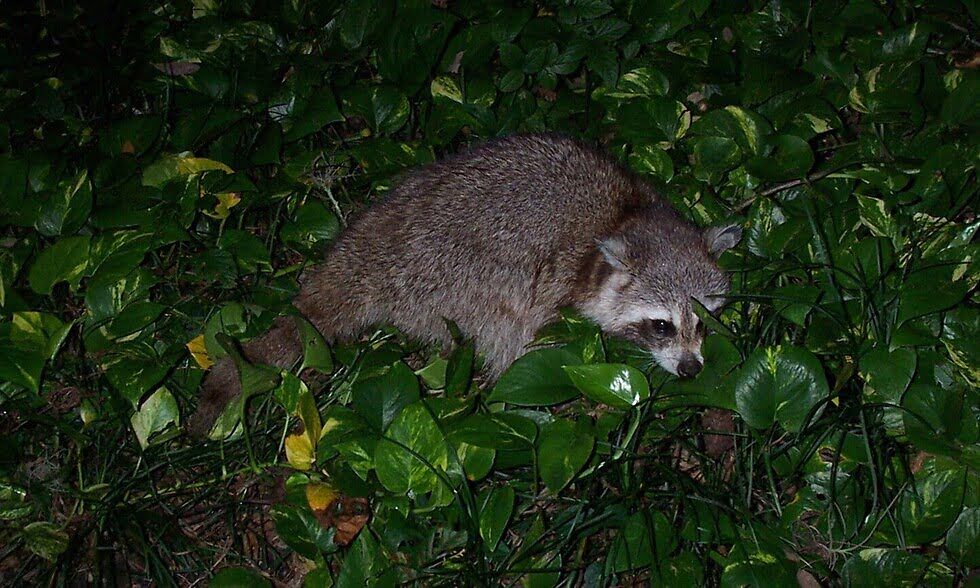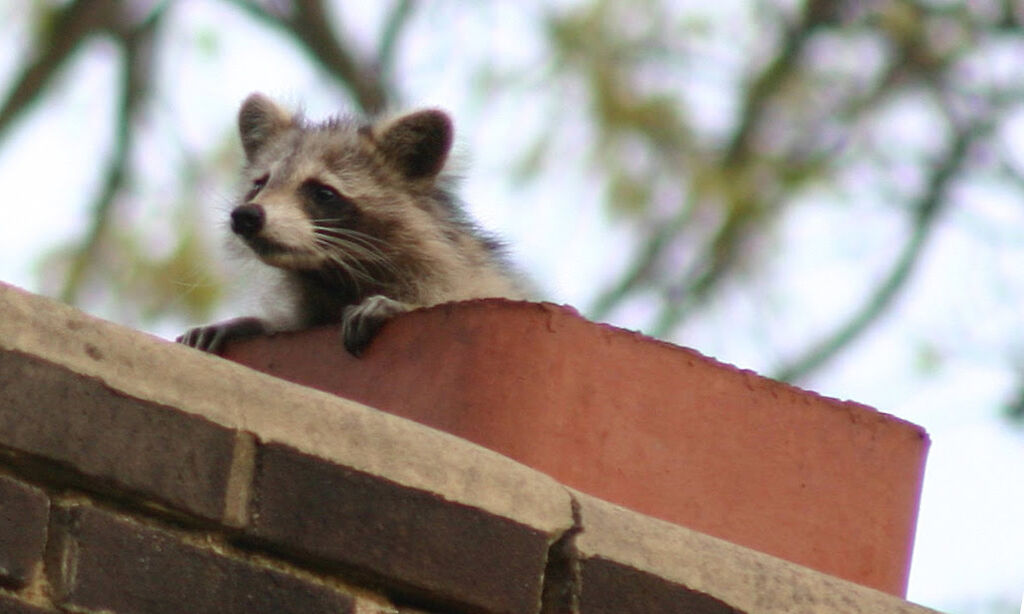In days gone by, the woodlands raccoon was chased by hunters and trappers for fur and meat, and so was conditioned to fear man and his activities. Raccoon trapping and hunting is declining as is woodland habitat. Fewer hollow trees means fewer traditional den sites, yet the raccoon population is at an all time high. What is going on?
The raccoon is adapting to the new paradigm...urban sprawl. City dwelling humans pay no attention to raccoons until they become a nuisance, cause damage, or are seen behaving oddly during the day. A rabid raccoon has no fear and will try to savage any living creature in it’s limited field of vision.
The only checks on raccoon populations today are the automobile, and mother nature with her assortment of population reducing fatal diseases. Urban blight with expansive tracts of abandoned homes combined with no humans provides endless opportunities for raccoons to colonize and thrive. The list of food available ranges from restaurant dumpsters to intentional feeding. A growing trend to repurpose tracts of blight into garden food plots is an additional source of food.
At some point, the local government is made aware and may have to form a plan to deal with the problem. The obvious long term solution is to make urban blight go away, but more commonly, a nuisance wildlife operator is hired to remove raccoons. Nuisance Wildlife Control businesses are solicited for bids, and the lucky winner gets free reign to trespass on any abandoned property, but may be restricted in the methods used. Raccoon trapping devices fall into two basic types - lethal and non-lethal. It is the lethal kind that is most often prohibited in cities, where traps may be seen, and accessed by random people. Even where lethal traps are allowed, caution is advised to prevent unintended outcomes.
Lethal traps, also called body grip or conibear traps, come in a variety of sizes depending on the size of the target animal. The following list shows the different size body grip traps and the intended target animal. There is some overlap. For example; a 330 and 280 are both effective traps for beavers. The 160, 220, 280 and 330 will all kill a raccoon with equal efficiency. In general, smaller animals can be caught in larger traps.
BODY GRIP TRAP SIZES AND TARGET ANIMALS
| #50-2 | 3 1/2″ x 4 1/2″ jaw spread, 4-way trigger | Mink, Muskrat, Weasel |  |
| 60-2 | Mink, Muskrat, Weasel |  |
|
| 110-2 | Mink, Muskrat, Opossum, Skunk, Weasel |  |
|
|
Marten, Mink, Muskrat, Opossum, Skunk, Weasel |
 |
||
|
Fisher, Marten, Nutria, Opossum, Raccoon, Skunk |
 |
||
|
Badger, Beaver, Fisher, Marten, Nutria, Opossum, Otter, Raccoon, Skunk |
 |
||
|
Badger, Beaver, Bobcat, Fisher, Lynx, Nutria, Otter, Raccoon |
 |
||
|
Beaver, Bobcat, Lynx, Otter |
 |
For example, muskrats are routinely caught in a 330 set for beaver, but a 110 set for muskrats will not catch a beaver. The traps most often used for raccoons are the 160 and 220. When allowed to use, these must be set in such a way as to avoid catching cats and dogs.


When the only traps allowed are non-lethal, the choices are dog-proof traps, cage traps, and cable restraints. The trapper must plan on how to deal with a live raccoon, an animal known for aggressively using its sharp claws and teeth against any and all opponents regardless of size. He must make sets that are not
visible to the public, and sets that do not attract non-target animals such as possums, skunks, kitties, etc.
DOG PROOF TRAPS
Recent developments in species specific traps let a trapper target raccoons, while excluding domestic dogs. These so-called “dog proof” traps are 100 % effective in excluding dogs. When set, the trap looks like a pipe sticking out of the ground. The raccoon reaches into the trap and grasps the trigger with its monkey-like fingers, and pulls the trigger upward, rather than pushing down. Using a sweet bait like marshmallow makes the trap even more selective in that domestic and feral cats are not attracted. Modifications: add a swivel near the end of the chain and cover the opening with a golf ball which prevents mice from getting the bait. Stake the trap

where the raccoon cannot reach anything solid to gain leverage. The downside of a dog proof trap must be considered in advance: a live and angry raccoon held by a staked-down trap is waiting for you...what are you going to do with it? If killing it on the spot is not an option, then this trap should not be used since any attempt to transfer the raccoon to a holding cage for removal, puts you in range of its teeth and claws. Using a snare pole would work but you would need two people since the two hands are needed to hold the thrashing raccoon in the snare pole, and two more hands to release the trap. Two hands plus two hands equals four hands!

Raccoon securely held in a dog proof trap
CAGE TRAPS
Not all cage traps (advertised for capturing raccoons) are equal. A raccoon is a strong animal that will test a cage trap to its limits...it will find any weakness, and tear at it. That destructive energy can be channelled to a stick placed inside the trap for the raccoon to chew on instead of fighting the trap. Also, they will
claw at the trap’s floor which is bad when a trap is set on a roof or any surface you do not want damaged. Prevent this by placing the trap on a piece of plywood. Keep in mind they will reach through the traps mesh to try and get at anything within reach, both top and sides.
Cage traps for professional raccoon trapping must be heavy duty. The expense is justified since the lighter cage traps sold at retail outlets will be rendered useless in short order.
Here is one example of a heavy duty cage trap made by the Duke Trap Co.

HD X-Large Cage Trap
- Model: 1114
- UPC: 01162701114
- L”x W”x H”: 36 x 15 x 14
- Target: Large Raccoon, Fox, Cat
- $64.99
As with the dog proof trap, using a sweet bait like marshmallow makes the set unattractive to cats. Make a trail of mini-marshmallows,, leading to the trap spaced roughly six feet apart, with a pile of the regular size marshmallows in the back of the trap beyond the trip pan.
CABLE RESTRAINTS
Modern cable restraints, also called snares, are designed to hold the animal by the body, neck or leg. The “relaxing” kind of locking mechanism makes the snare non-lethal.
CABLE RESTRAINT

↑Relaxing Lock↑
Another requirement for not-lethality is ensuring the animal cannot get “entangled” after being captured by the snare. If the animal does get entangled and cannot get its feet back on the ground, it may be asphyxiated. Common
entanglements to avoid are fences, flexible saplings, and brush piles. Large trees are okay.
Snare sets do not generally rely on bait, but are placed in line with a visible trail or pinch point where the raccoon is forced by obstacles. Snare loop diameter for raccoons is 8-10 inches, with the height of the bottom of the loop 3-5 inches above ground level.
Most raccoons are snared around the body and can be maneuvered into a transfer cage then cutting the snare cable (snare cable is one use only.) The swivel(s) and snare lock are reusable.
LURING RACCOONS
Raccoon lures appeal to the sense of smell, and may be used where the set is not visible at ground level. As with baits, sweet based lures do not appeal to cats. A notable exception are lures made from male raccoon glands and urine. Typically these are used during mating season and will attract larger, more dominant male raccoons looking for a fight. These lures have the opposite effect on female raccoons and can be used to repel them from making a nest.


